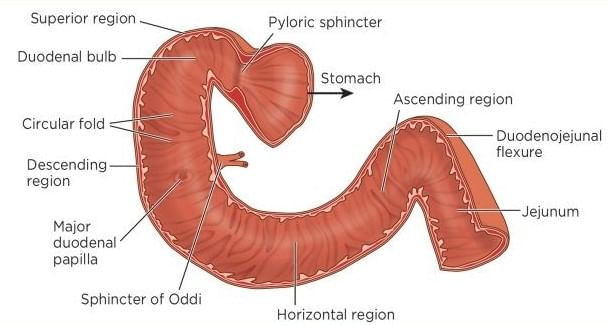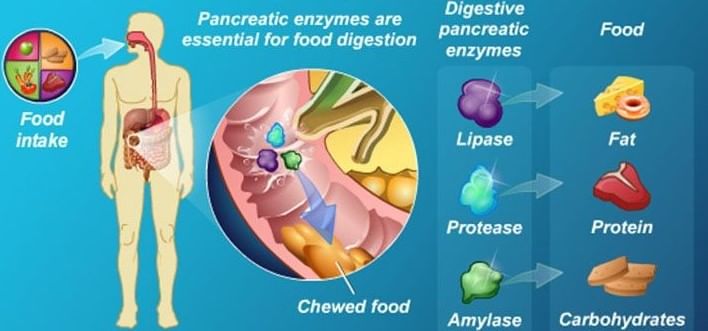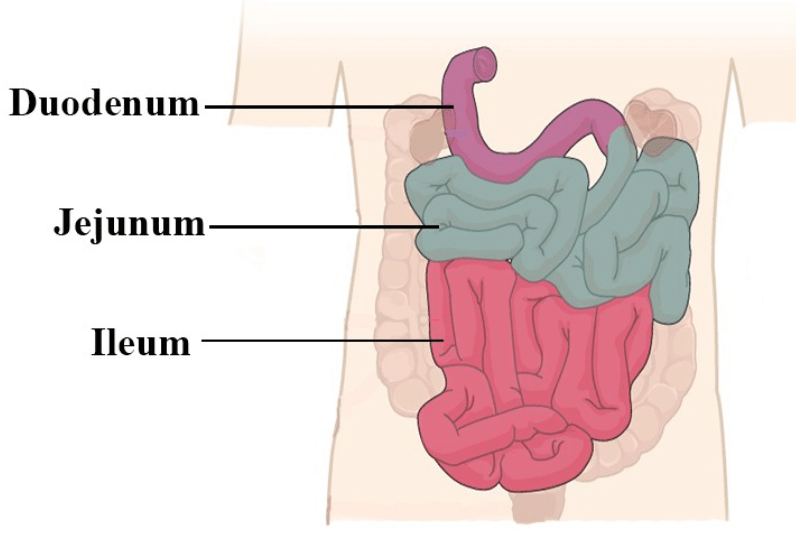Chemical Digestion: Digestion of Food | Additional Study Material for NEET PDF Download
Chemical Digestion
➢ Digestion of Food in Duodenum
- When food leaves the stomach through its pyloric end and enters the duodenum it is called chyme (acidic).
 Internal Structure of Duodenum
Internal Structure of Duodenum - The HCl of chyme stimulates different enteroendocrine cells which are found in the intestinal gland or crypts of liberkuhn, in these specific modified cells are called K-cells which secrete glucose-dependent insulinotropic peptide or GIP, this hormone stimulates the secretion of insulin.
- Including this, the following hormones also secrete through the duodenum:
(i) Secretin: It is the most important hormone of the digestive tract and also the first discovered hormone. This hormone stimulates the pancreas for synthesis and secretion of the non-enzymatic part of pancreatic juice. It also stimulates the liver for secretion of bile juice and inhibit the gastric juice secretion in the stomach and reduce the rate of contraction of the stomach.
(ii) Pancreozymin: It stimulates the synthesis as well as secretion of pancreatic-juices. Secretin promotes the secretion of the non-enzymatic part of the pancreatic juice, while pancreozymin promotes the secretion of the enzymatic part of the pancreatic juice.
(iii) Hepatocrinin: It promotes the synthesis and secretion of bile juice in the liver.
(iv) Cholecystokinin: It stimulates the liver and the gallbladder (mainly gallbladder) to secrete Bile-juice.
(v) Duocrinin: It stimulates the Brunner's gland for synthesis and secretion of the non-enzymatic part of intestinal juice.
(vi) Enterocrinin: This hormone stimulates Paneth cells for synthesis and secretion of enzymatic part of intestinal juice.
(vii) Villikinin: It stimulates the activity of villi.
(viii) Enterogasterone: It inhibits the secretion of HCl in the stomach.
(ix) Gastric Inhibitory Peptide (GIP): In inhibits the secretion of gastrin hormone.
(x) Vasoactive intestinal peptide and somatostatin: They inhibits the motility of the stomach.
➢ Bile Juice
- In the proximal part of the duodenum, bile-juice is secreted. The parenchyma cells of the liver produce bile-juice and it is stored in the gallbladder.
Different Types of Digestive Juice
- Bile-juice does not contain any digestive enzyme. Therefore it is not a true digestive juice (Pseudodigestive juice).
► Composition of Bile Juice
- Bile-juice is a greenish (Biliverdin) yellow (Bilirubin) coloured alkaline fluid.
► Composition of Liver Bile
- Liver bile pH is 8.0.
- H2O: 98%
- Organic constituents are bile acid, bile pigment, cholesterol, Lecithin, inorganic constituents Na+, K+ etc.
- Bile pigments are the excretory substances of the liver.
► Types of Bile Salts
Bile salts are of two types:
(a) Inorganic Salts: Bile juice contains NaCl, Na2CO3, NaHCO3 etc. in it. Inorganic salts neutralize the acidity of the food and make the medium basic. It is necessary for the medium to become basic because the pancreatic-juices enzymes can act only in the basic-medium.
(b) Organic Salts: Organic salts like Na-glycocholate and Na-taurocholate are found in Bile juice. The main function of these salts is the emulsification of fats. Because pancreatic lipase can act only on emulsified fats.
Bile salts also help in the absorption of fats and fat-soluble vitamins (A, D, E, K). Bile salts combine with fats, cholesterol, phospholipid (lecithin) and these vitamins to form compounds called Micelles which are absorbed rapidly. In the form of micelles, cholesterol and phospholipid (lecithin) remain soluble.
► Functions of Bile Juice
Neutralization of HCl: Its sodium neutralizes HCl of chyme (semifluid food found in the stomach).
Emulsification: Sodium glycocholate and sodium taurocholate are bile salts that break the large fat droplets into smaller ones.
Absorption of Fat and Fat-soluble Vitamins: Its salts help in the absorption of fat (fatty acids and glycerol) and fat-soluble vitamins (A, D, E and K).
Excretion: Bile pigments (bilirubin and biliverdin) are excretory products.
Prevention of Decomposition: Bile is alkaline hence it prevents the decomposition of food preventing the growth of bacteria on it.
Stimulation of Peristalsis: Bile increases the peristalsis of the intestine.
Activation of Lipase: Bile contains no enzyme but activates the enzyme lipase.
Bile-pigments, cholesterol and Lecithin are the excretory substances found in Bile juice.
Gall Stone: Sometimes the passage inside the bile-duct gets blocked or becomes narrow, so the cholesterol gets deposited or precipitated in the gall-bladder. This is termed as the Gall-stone (cholelithiasis).
Obstructive Jaundice: If the passage of bile is blocked then the amount of bilirubin increases in the blood. So the yellowish colouration of the body like skin, cornea and nails appear yellow. Urine also becomes yellow.
➢
Pancreatic Juice
- Pancreozymin stimulates the acini and glandular cells so pancreatic juice is secreted.
The pancreatic juice is secreted by the exocrine cells of the pancreas.
Pancreatic juice is a highly odoriferous, colourless basic fluid which contains enzymes and salts.
 Role of Pancreatic Enzymes
Role of Pancreatic Enzymes
► Composition of Pancreatic Juice
- Total amount in man = 500-800 ml/day
- Water = 98%
- pH = 7.5-8.3
- Salts = 2%
- Pancreatic juice contains only inorganic salts.
The action of enzymes present in the pancreatic juice is as follows:
- Pancreatic α - Amylase: Amylase and Amylopsin dissociates starch into Maltose. The majority of starch breaks up into the duodenum.
- Trypsinogen and Chymotrypsinogen: The step by step action of these enzymes is as follows:

- Enterokinase is secreted by the Duodenal mucosa.
- Trypsin and chymotrypsin are Endopeptidase type of enzymes. They dissociate proteins into peptones and proteoses. The majority of proteins are broken into the stomach and the remaining are broken into the duodenum.

- Procarboxy Peptidase: These are also called zymogens. Trypsin converts it into active Carboxy-peptidase.

- Fat Digesting Enzyme: In pancreatic juices, various Fat-digesting enzymes are found which are collectively called steapsin.
- Pancreatic Lipase: It converts triglyceride into monoglyceride, fatty acid, glycerol.
- Cholesterol Esterase: It digests cholesterol esters. These esters are made up of cholesterol and fatty-acids like Lanolin, cholesterol and Palmitic acid.
- Phospholipase: These digest phospholipids.
- DNase and RNase: Digestion of DNA and RNA.
➢
Digestion in Jejunum and Ileum
- These hormones stimulate the crypts of Leiberkuhn to secrete Succus-entericus or intestinal juice. This succus entericus mainly contains water (99%) and digestive enzymes (<1%). Intestinal juice act on the food.
 Different Parts of Small Intestine
Different Parts of Small Intestine - Succus-entericus mainly contains the following enzymes Peptidase or Erepsin. This is a type of Exopeptidase. It converts oligopeptides into amino-acids.
- Disaccharidases Sucrase: It is also known as Invertase. It converts sucrose into glucose and fructose.
- Maltase: It converts maltose sugar into glucose molecules.
- Lactase: This enzyme is found only in mammals. It converts milk sugar Lactose into glucose and galactose.
- Intestinal Lipase: This fat-digesting enzyme converts fats into fatty acids and glycerol.
- Nucleotidase and Nucleosidase: These act in the following way:


- Maximum digestion of carbohydrates is done in the duodenum, but its digestion is completed in Jejunum.
An Overview of the Action of Major Enzymes in Human
Enzyme | Site of Action | Substrate | Products of Action | |
Salivary Juice (Salivary Gland) | ||||
Salivary amylase or Ptyalin | Mouth and Stomach | Starch | Disaccharides (few) | |
|
| Buccal cavity |
|
|
Gastric Juice (Stomach) | ||||
a) | Pepsinogen: pepsin | Stomach | Proteins | large peptides |
Pancreatic Juice (Pancreas) | ||||
a) | Pancreatic a-amylase ( Duodenum) | Small, intestine | Starch | Disaccharides |
b) | Trypsinogen: trypsin | Small, intestine | Proteins | large peptides |
| Chymotrypsin | Small, intestine | Proteins | large peptides |
d) | Elastase | Small, intestine | Elastin | Oligopeptides |
e) | Carboxypeptidases | Small, intestine | large peptides | Amino-acid |
f) | Aminopeptidase | Small, intestine | large peptides | Oligopeptides |
g) | lipase | Small, intestine | Triglycerides, fatty acids, glycerol | Monoglycerides |
h) | Nucleases | Small, intestine | Nucleic acids | Nucleotides |
Intestinal Juice (Small Intestine) | ||||
a | Enteropeptidase or enterokinase | Duodenum | Trypsinogen | Trypsin |
b | Peptidase | Duodenum | Oligopeptides | Amino acids |
c | Disaecharidases | Duodenum | Disaccharides | Monosaccharides |
d | Nucleotidase | Duodenum | Nucleotides phosphoric: acid | Nucleosidases |
e) | Nucleosidases | Duodenum | Nucleosides pyrimidines | Sugars, purines |
Role of some major Gastrointestinal Peptide Hormones in Digestion:
- Hormone: Gastrin
Source Secretion: Pyloric stomach and duodenum / G-cells.
Stimulus to: Vagus nerve activity; peptides and proteins in the stomach.
Target / Action: Secretory cells and muscles of the stomach; secretion of HCl and stimulation of gastric motility. - Hormone: Cholecystokinin (CCK)
Source Secretion: Upper small intestine (Duodenum)
Stimulus to: Food (fatty chyme and amino acids) in the duodenum.
Target / Action: Gall bladder; contraction of gall bladder (bile release). - Hormone: Secretin
Source Secretion: Inttiralvall (Duodenum)
Stimulus to: Food and strong acid in stomach and intestine.
Target / Action: Pancreas, secretory cells and muscles of the stomach; secretion of water and bicarbonate(NaHCO3); inhibition of gastric motility. - Hormone: Gastric Inhibitory Peptide (GIP)
Source Secretion: Upper small intestine (Duodenum)
Stimulus to: Monosaccharides and fats (fatty chyme) in the duodenum.
Target / Action: Gastric mucosa and muscles; inhibition of gastric secretion and mobility/motility (slowing food passage).
➢
Digestion in Caecum
➢
In herbivores, the symbiotic bacteria and protozoans present in the caecum help in the digestion of cellulose into glucose. So the digestion of cellulose takes place in the caecum by the process of decomposition.
This decomposition process is very slow. So very less amount of cellulose is digested at a time in the caecum.
In the last part of the large intestine, faeces is temporarily stored.
Note:
- Maximum digestion of food – Duodenum
- While digestion of food completes in – Jejunum
- Maximum absorption of food in – Jejunum
|
26 videos|312 docs|64 tests
|
FAQs on Chemical Digestion: Digestion of Food - Additional Study Material for NEET
| 1. What is chemical digestion? |  |
| 2. How does chemical digestion occur in the body? |  |
| 3. What are enzymes and their role in chemical digestion? |  |
| 4. How does the body absorb nutrients after chemical digestion? |  |
| 5. What factors can affect chemical digestion? |  |

















